Essay: Cognitive and Social Development in Human Life Transitions
VerifiedAdded on 2020/03/23
|7
|1806
|68
Essay
AI Summary
This essay delves into the multifaceted aspects of human life transitions, primarily focusing on the cognitive and social development of children, using the case of a child named Jack and his mother, Venessa, as a focal point. The essay applies the theories of Jean Piaget, specifically the sensorimotor and preoperational stages, to analyze Jack's cognitive development, explaining the factors that might have hindered his language acquisition, such as his mother's working schedule and limited interaction. Furthermore, the essay incorporates Erik Erikson's theory of psychosocial development, particularly the autonomy versus shame and doubt stage, to explore the impact of parenting styles and environmental factors on the child's social and emotional growth, including the development of toileting habits. The essay concludes by proposing interventions and recommendations for the mother, suggesting workshops and community meetings to enhance her understanding of child development, and the importance of quality time with the child to foster healthy cognitive and social development.
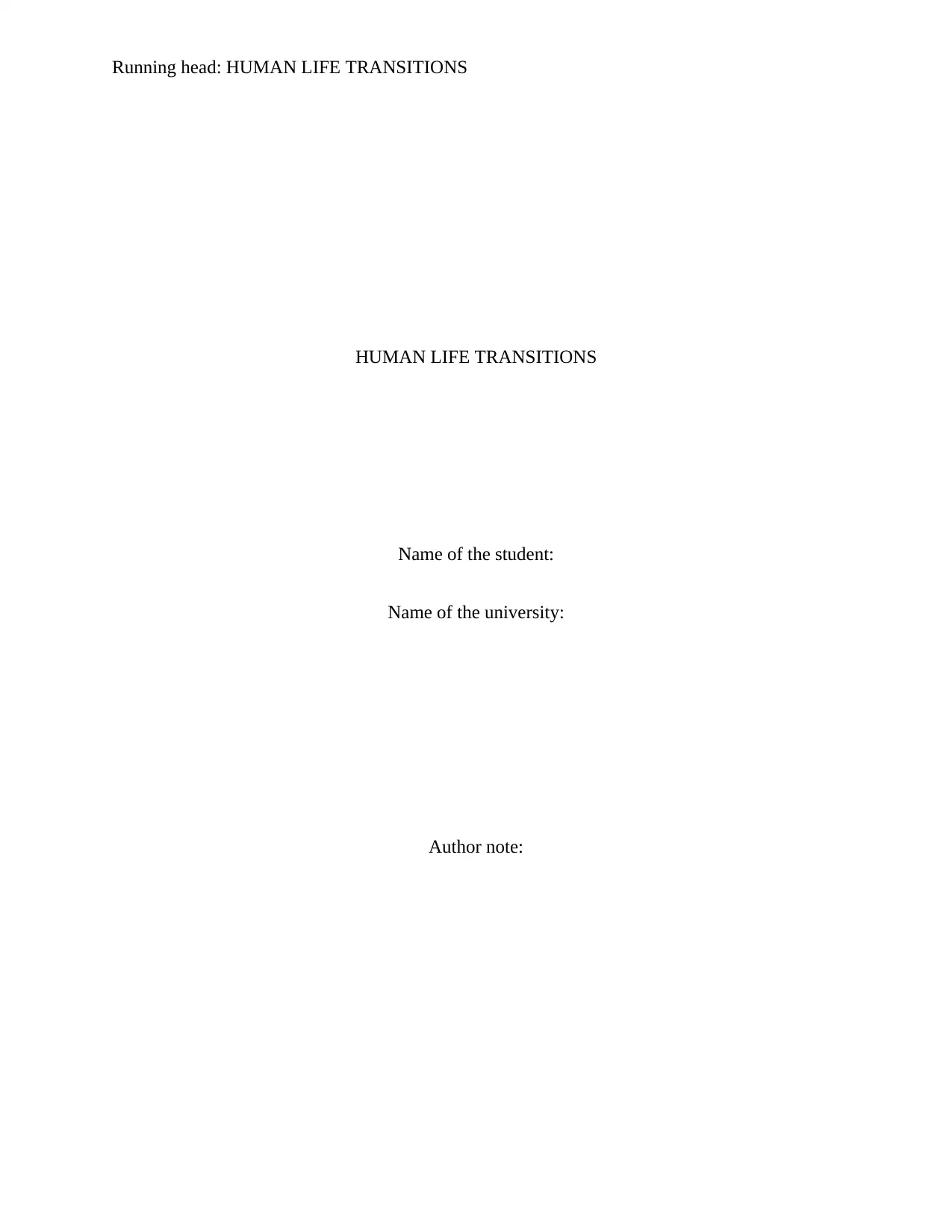
Running head: HUMAN LIFE TRANSITIONS
HUMAN LIFE TRANSITIONS
Name of the student:
Name of the university:
Author note:
HUMAN LIFE TRANSITIONS
Name of the student:
Name of the university:
Author note:
Paraphrase This Document
Need a fresh take? Get an instant paraphrase of this document with our AI Paraphraser
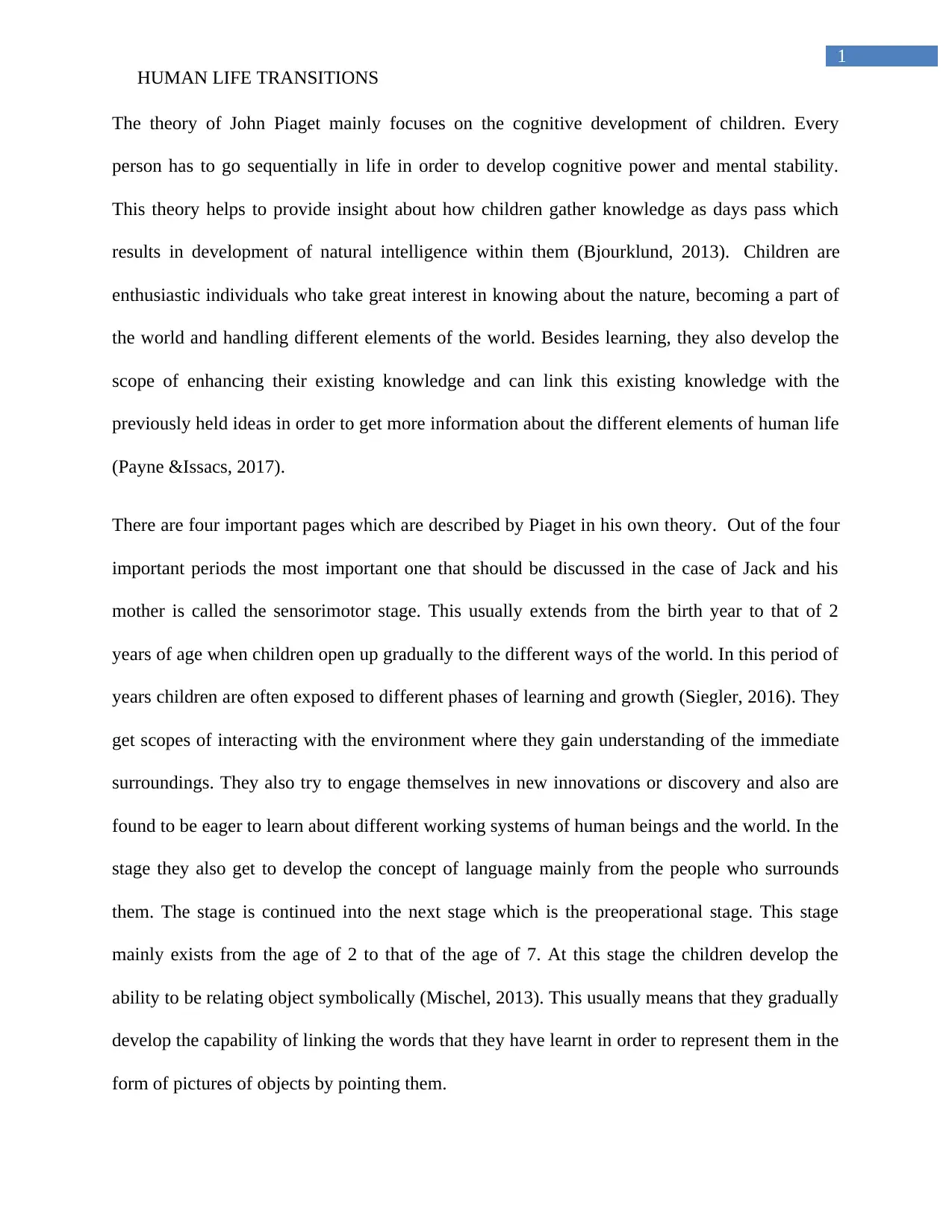
1
HUMAN LIFE TRANSITIONS
The theory of John Piaget mainly focuses on the cognitive development of children. Every
person has to go sequentially in life in order to develop cognitive power and mental stability.
This theory helps to provide insight about how children gather knowledge as days pass which
results in development of natural intelligence within them (Bjourklund, 2013). Children are
enthusiastic individuals who take great interest in knowing about the nature, becoming a part of
the world and handling different elements of the world. Besides learning, they also develop the
scope of enhancing their existing knowledge and can link this existing knowledge with the
previously held ideas in order to get more information about the different elements of human life
(Payne &Issacs, 2017).
There are four important pages which are described by Piaget in his own theory. Out of the four
important periods the most important one that should be discussed in the case of Jack and his
mother is called the sensorimotor stage. This usually extends from the birth year to that of 2
years of age when children open up gradually to the different ways of the world. In this period of
years children are often exposed to different phases of learning and growth (Siegler, 2016). They
get scopes of interacting with the environment where they gain understanding of the immediate
surroundings. They also try to engage themselves in new innovations or discovery and also are
found to be eager to learn about different working systems of human beings and the world. In the
stage they also get to develop the concept of language mainly from the people who surrounds
them. The stage is continued into the next stage which is the preoperational stage. This stage
mainly exists from the age of 2 to that of the age of 7. At this stage the children develop the
ability to be relating object symbolically (Mischel, 2013). This usually means that they gradually
develop the capability of linking the words that they have learnt in order to represent them in the
form of pictures of objects by pointing them.
HUMAN LIFE TRANSITIONS
The theory of John Piaget mainly focuses on the cognitive development of children. Every
person has to go sequentially in life in order to develop cognitive power and mental stability.
This theory helps to provide insight about how children gather knowledge as days pass which
results in development of natural intelligence within them (Bjourklund, 2013). Children are
enthusiastic individuals who take great interest in knowing about the nature, becoming a part of
the world and handling different elements of the world. Besides learning, they also develop the
scope of enhancing their existing knowledge and can link this existing knowledge with the
previously held ideas in order to get more information about the different elements of human life
(Payne &Issacs, 2017).
There are four important pages which are described by Piaget in his own theory. Out of the four
important periods the most important one that should be discussed in the case of Jack and his
mother is called the sensorimotor stage. This usually extends from the birth year to that of 2
years of age when children open up gradually to the different ways of the world. In this period of
years children are often exposed to different phases of learning and growth (Siegler, 2016). They
get scopes of interacting with the environment where they gain understanding of the immediate
surroundings. They also try to engage themselves in new innovations or discovery and also are
found to be eager to learn about different working systems of human beings and the world. In the
stage they also get to develop the concept of language mainly from the people who surrounds
them. The stage is continued into the next stage which is the preoperational stage. This stage
mainly exists from the age of 2 to that of the age of 7. At this stage the children develop the
ability to be relating object symbolically (Mischel, 2013). This usually means that they gradually
develop the capability of linking the words that they have learnt in order to represent them in the
form of pictures of objects by pointing them.
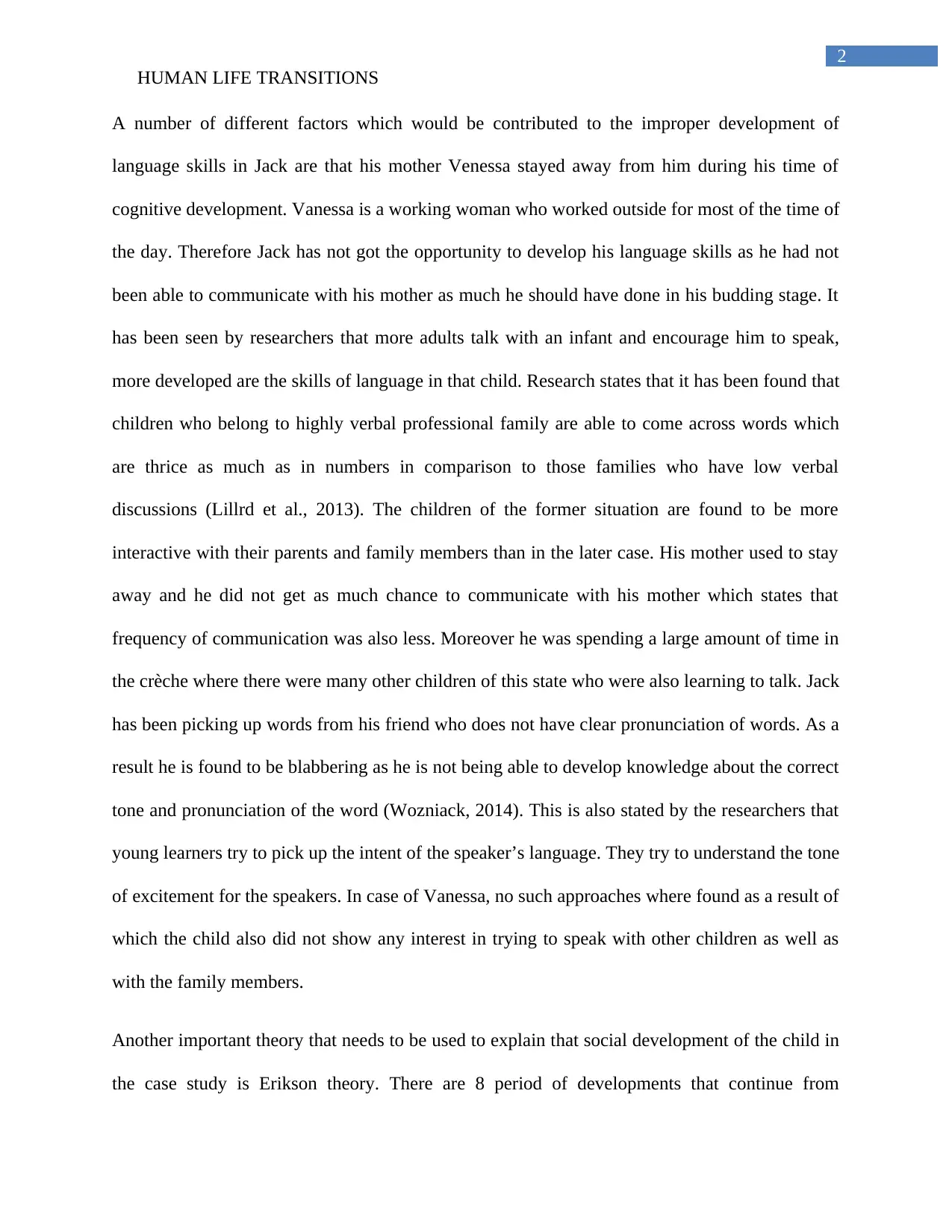
2
HUMAN LIFE TRANSITIONS
A number of different factors which would be contributed to the improper development of
language skills in Jack are that his mother Venessa stayed away from him during his time of
cognitive development. Vanessa is a working woman who worked outside for most of the time of
the day. Therefore Jack has not got the opportunity to develop his language skills as he had not
been able to communicate with his mother as much he should have done in his budding stage. It
has been seen by researchers that more adults talk with an infant and encourage him to speak,
more developed are the skills of language in that child. Research states that it has been found that
children who belong to highly verbal professional family are able to come across words which
are thrice as much as in numbers in comparison to those families who have low verbal
discussions (Lillrd et al., 2013). The children of the former situation are found to be more
interactive with their parents and family members than in the later case. His mother used to stay
away and he did not get as much chance to communicate with his mother which states that
frequency of communication was also less. Moreover he was spending a large amount of time in
the crèche where there were many other children of this state who were also learning to talk. Jack
has been picking up words from his friend who does not have clear pronunciation of words. As a
result he is found to be blabbering as he is not being able to develop knowledge about the correct
tone and pronunciation of the word (Wozniack, 2014). This is also stated by the researchers that
young learners try to pick up the intent of the speaker’s language. They try to understand the tone
of excitement for the speakers. In case of Vanessa, no such approaches where found as a result of
which the child also did not show any interest in trying to speak with other children as well as
with the family members.
Another important theory that needs to be used to explain that social development of the child in
the case study is Erikson theory. There are 8 period of developments that continue from
HUMAN LIFE TRANSITIONS
A number of different factors which would be contributed to the improper development of
language skills in Jack are that his mother Venessa stayed away from him during his time of
cognitive development. Vanessa is a working woman who worked outside for most of the time of
the day. Therefore Jack has not got the opportunity to develop his language skills as he had not
been able to communicate with his mother as much he should have done in his budding stage. It
has been seen by researchers that more adults talk with an infant and encourage him to speak,
more developed are the skills of language in that child. Research states that it has been found that
children who belong to highly verbal professional family are able to come across words which
are thrice as much as in numbers in comparison to those families who have low verbal
discussions (Lillrd et al., 2013). The children of the former situation are found to be more
interactive with their parents and family members than in the later case. His mother used to stay
away and he did not get as much chance to communicate with his mother which states that
frequency of communication was also less. Moreover he was spending a large amount of time in
the crèche where there were many other children of this state who were also learning to talk. Jack
has been picking up words from his friend who does not have clear pronunciation of words. As a
result he is found to be blabbering as he is not being able to develop knowledge about the correct
tone and pronunciation of the word (Wozniack, 2014). This is also stated by the researchers that
young learners try to pick up the intent of the speaker’s language. They try to understand the tone
of excitement for the speakers. In case of Vanessa, no such approaches where found as a result of
which the child also did not show any interest in trying to speak with other children as well as
with the family members.
Another important theory that needs to be used to explain that social development of the child in
the case study is Erikson theory. There are 8 period of developments that continue from
⊘ This is a preview!⊘
Do you want full access?
Subscribe today to unlock all pages.

Trusted by 1+ million students worldwide
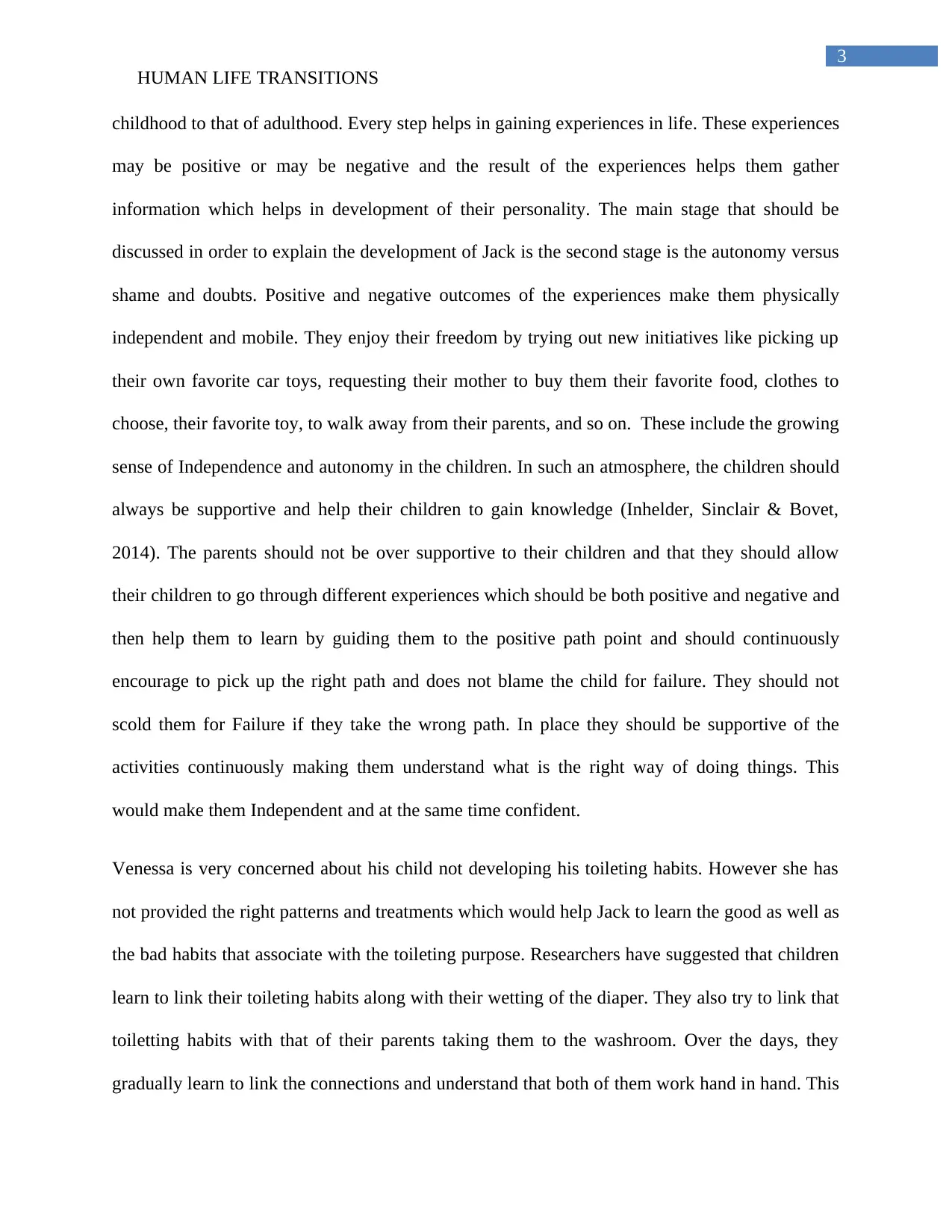
3
HUMAN LIFE TRANSITIONS
childhood to that of adulthood. Every step helps in gaining experiences in life. These experiences
may be positive or may be negative and the result of the experiences helps them gather
information which helps in development of their personality. The main stage that should be
discussed in order to explain the development of Jack is the second stage is the autonomy versus
shame and doubts. Positive and negative outcomes of the experiences make them physically
independent and mobile. They enjoy their freedom by trying out new initiatives like picking up
their own favorite car toys, requesting their mother to buy them their favorite food, clothes to
choose, their favorite toy, to walk away from their parents, and so on. These include the growing
sense of Independence and autonomy in the children. In such an atmosphere, the children should
always be supportive and help their children to gain knowledge (Inhelder, Sinclair & Bovet,
2014). The parents should not be over supportive to their children and that they should allow
their children to go through different experiences which should be both positive and negative and
then help them to learn by guiding them to the positive path point and should continuously
encourage to pick up the right path and does not blame the child for failure. They should not
scold them for Failure if they take the wrong path. In place they should be supportive of the
activities continuously making them understand what is the right way of doing things. This
would make them Independent and at the same time confident.
Venessa is very concerned about his child not developing his toileting habits. However she has
not provided the right patterns and treatments which would help Jack to learn the good as well as
the bad habits that associate with the toileting purpose. Researchers have suggested that children
learn to link their toileting habits along with their wetting of the diaper. They also try to link that
toiletting habits with that of their parents taking them to the washroom. Over the days, they
gradually learn to link the connections and understand that both of them work hand in hand. This
HUMAN LIFE TRANSITIONS
childhood to that of adulthood. Every step helps in gaining experiences in life. These experiences
may be positive or may be negative and the result of the experiences helps them gather
information which helps in development of their personality. The main stage that should be
discussed in order to explain the development of Jack is the second stage is the autonomy versus
shame and doubts. Positive and negative outcomes of the experiences make them physically
independent and mobile. They enjoy their freedom by trying out new initiatives like picking up
their own favorite car toys, requesting their mother to buy them their favorite food, clothes to
choose, their favorite toy, to walk away from their parents, and so on. These include the growing
sense of Independence and autonomy in the children. In such an atmosphere, the children should
always be supportive and help their children to gain knowledge (Inhelder, Sinclair & Bovet,
2014). The parents should not be over supportive to their children and that they should allow
their children to go through different experiences which should be both positive and negative and
then help them to learn by guiding them to the positive path point and should continuously
encourage to pick up the right path and does not blame the child for failure. They should not
scold them for Failure if they take the wrong path. In place they should be supportive of the
activities continuously making them understand what is the right way of doing things. This
would make them Independent and at the same time confident.
Venessa is very concerned about his child not developing his toileting habits. However she has
not provided the right patterns and treatments which would help Jack to learn the good as well as
the bad habits that associate with the toileting purpose. Researchers have suggested that children
learn to link their toileting habits along with their wetting of the diaper. They also try to link that
toiletting habits with that of their parents taking them to the washroom. Over the days, they
gradually learn to link the connections and understand that both of them work hand in hand. This
Paraphrase This Document
Need a fresh take? Get an instant paraphrase of this document with our AI Paraphraser
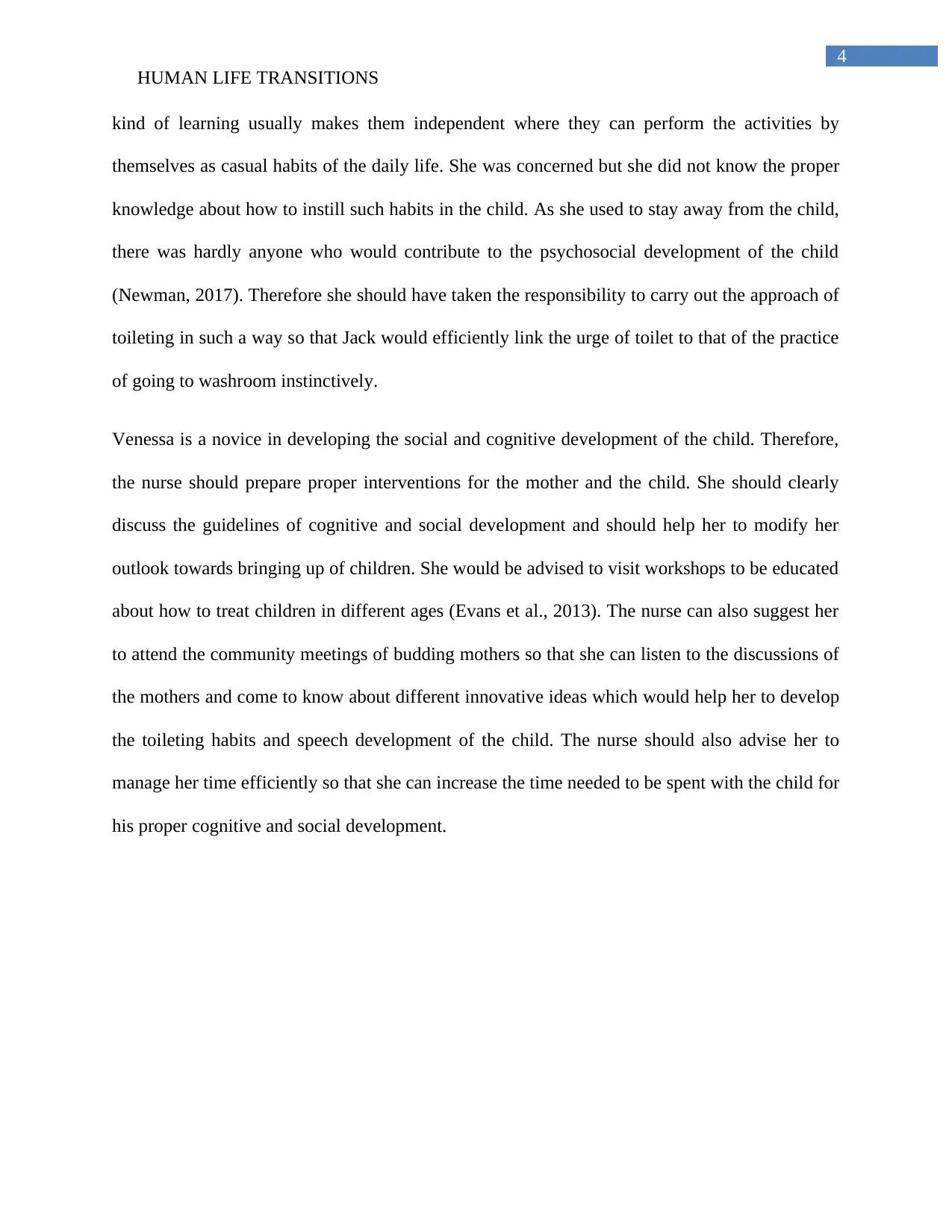
4
HUMAN LIFE TRANSITIONS
kind of learning usually makes them independent where they can perform the activities by
themselves as casual habits of the daily life. She was concerned but she did not know the proper
knowledge about how to instill such habits in the child. As she used to stay away from the child,
there was hardly anyone who would contribute to the psychosocial development of the child
(Newman, 2017). Therefore she should have taken the responsibility to carry out the approach of
toileting in such a way so that Jack would efficiently link the urge of toilet to that of the practice
of going to washroom instinctively.
Venessa is a novice in developing the social and cognitive development of the child. Therefore,
the nurse should prepare proper interventions for the mother and the child. She should clearly
discuss the guidelines of cognitive and social development and should help her to modify her
outlook towards bringing up of children. She would be advised to visit workshops to be educated
about how to treat children in different ages (Evans et al., 2013). The nurse can also suggest her
to attend the community meetings of budding mothers so that she can listen to the discussions of
the mothers and come to know about different innovative ideas which would help her to develop
the toileting habits and speech development of the child. The nurse should also advise her to
manage her time efficiently so that she can increase the time needed to be spent with the child for
his proper cognitive and social development.
HUMAN LIFE TRANSITIONS
kind of learning usually makes them independent where they can perform the activities by
themselves as casual habits of the daily life. She was concerned but she did not know the proper
knowledge about how to instill such habits in the child. As she used to stay away from the child,
there was hardly anyone who would contribute to the psychosocial development of the child
(Newman, 2017). Therefore she should have taken the responsibility to carry out the approach of
toileting in such a way so that Jack would efficiently link the urge of toilet to that of the practice
of going to washroom instinctively.
Venessa is a novice in developing the social and cognitive development of the child. Therefore,
the nurse should prepare proper interventions for the mother and the child. She should clearly
discuss the guidelines of cognitive and social development and should help her to modify her
outlook towards bringing up of children. She would be advised to visit workshops to be educated
about how to treat children in different ages (Evans et al., 2013). The nurse can also suggest her
to attend the community meetings of budding mothers so that she can listen to the discussions of
the mothers and come to know about different innovative ideas which would help her to develop
the toileting habits and speech development of the child. The nurse should also advise her to
manage her time efficiently so that she can increase the time needed to be spent with the child for
his proper cognitive and social development.
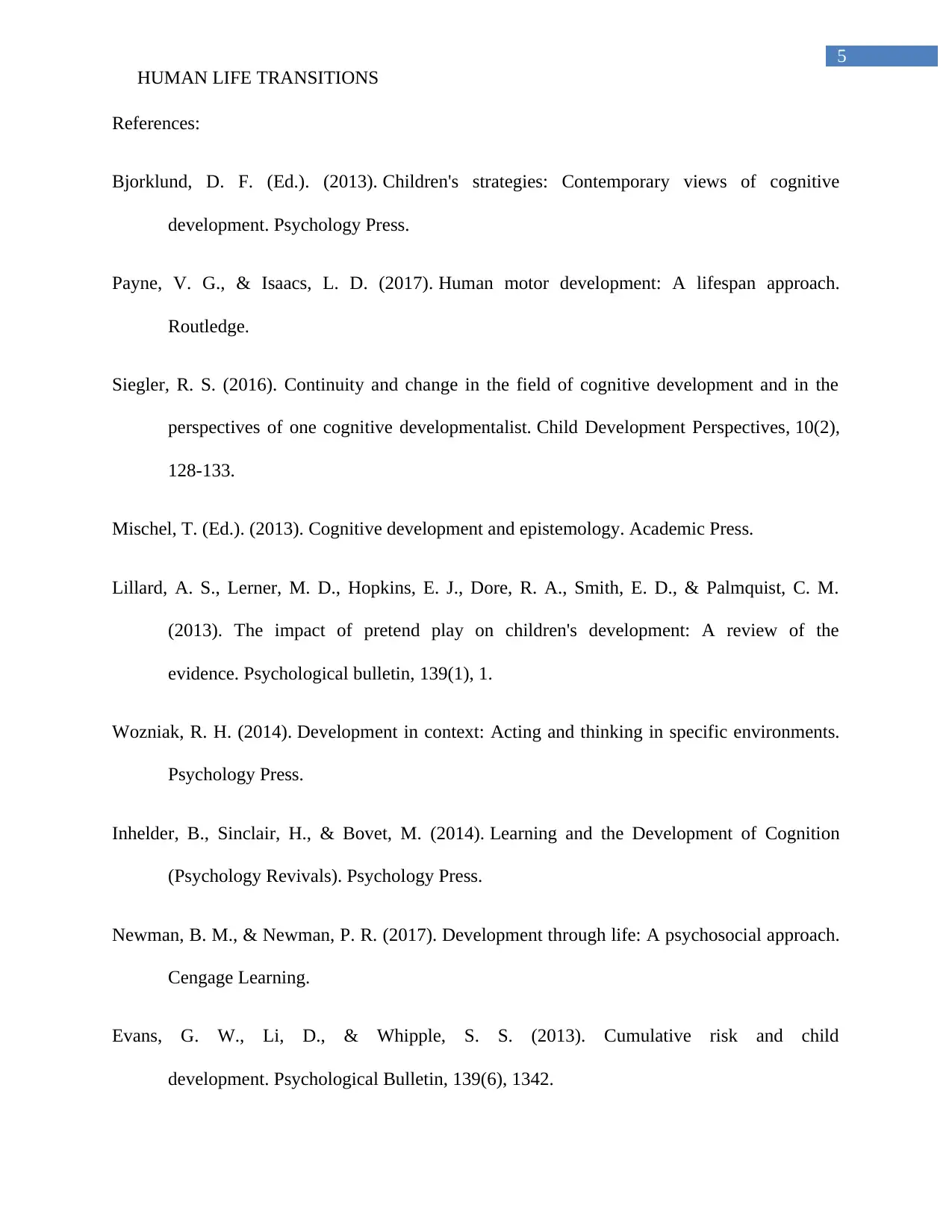
5
HUMAN LIFE TRANSITIONS
References:
Bjorklund, D. F. (Ed.). (2013). Children's strategies: Contemporary views of cognitive
development. Psychology Press.
Payne, V. G., & Isaacs, L. D. (2017). Human motor development: A lifespan approach.
Routledge.
Siegler, R. S. (2016). Continuity and change in the field of cognitive development and in the
perspectives of one cognitive developmentalist. Child Development Perspectives, 10(2),
128-133.
Mischel, T. (Ed.). (2013). Cognitive development and epistemology. Academic Press.
Lillard, A. S., Lerner, M. D., Hopkins, E. J., Dore, R. A., Smith, E. D., & Palmquist, C. M.
(2013). The impact of pretend play on children's development: A review of the
evidence. Psychological bulletin, 139(1), 1.
Wozniak, R. H. (2014). Development in context: Acting and thinking in specific environments.
Psychology Press.
Inhelder, B., Sinclair, H., & Bovet, M. (2014). Learning and the Development of Cognition
(Psychology Revivals). Psychology Press.
Newman, B. M., & Newman, P. R. (2017). Development through life: A psychosocial approach.
Cengage Learning.
Evans, G. W., Li, D., & Whipple, S. S. (2013). Cumulative risk and child
development. Psychological Bulletin, 139(6), 1342.
HUMAN LIFE TRANSITIONS
References:
Bjorklund, D. F. (Ed.). (2013). Children's strategies: Contemporary views of cognitive
development. Psychology Press.
Payne, V. G., & Isaacs, L. D. (2017). Human motor development: A lifespan approach.
Routledge.
Siegler, R. S. (2016). Continuity and change in the field of cognitive development and in the
perspectives of one cognitive developmentalist. Child Development Perspectives, 10(2),
128-133.
Mischel, T. (Ed.). (2013). Cognitive development and epistemology. Academic Press.
Lillard, A. S., Lerner, M. D., Hopkins, E. J., Dore, R. A., Smith, E. D., & Palmquist, C. M.
(2013). The impact of pretend play on children's development: A review of the
evidence. Psychological bulletin, 139(1), 1.
Wozniak, R. H. (2014). Development in context: Acting and thinking in specific environments.
Psychology Press.
Inhelder, B., Sinclair, H., & Bovet, M. (2014). Learning and the Development of Cognition
(Psychology Revivals). Psychology Press.
Newman, B. M., & Newman, P. R. (2017). Development through life: A psychosocial approach.
Cengage Learning.
Evans, G. W., Li, D., & Whipple, S. S. (2013). Cumulative risk and child
development. Psychological Bulletin, 139(6), 1342.
⊘ This is a preview!⊘
Do you want full access?
Subscribe today to unlock all pages.

Trusted by 1+ million students worldwide

6
HUMAN LIFE TRANSITIONS
Lillard, A. S., Lerner, M. D., Hopkins, E. J., Dore, R. A., Smith, E. D., & Palmquist, C. M.
(2013). The impact of pretend play on children's development: A review of the
evidence. Psychological bulletin, 139(1), 1.
HUMAN LIFE TRANSITIONS
Lillard, A. S., Lerner, M. D., Hopkins, E. J., Dore, R. A., Smith, E. D., & Palmquist, C. M.
(2013). The impact of pretend play on children's development: A review of the
evidence. Psychological bulletin, 139(1), 1.
1 out of 7
Related Documents
Your All-in-One AI-Powered Toolkit for Academic Success.
+13062052269
info@desklib.com
Available 24*7 on WhatsApp / Email
![[object Object]](/_next/static/media/star-bottom.7253800d.svg)
Unlock your academic potential
Copyright © 2020–2025 A2Z Services. All Rights Reserved. Developed and managed by ZUCOL.




